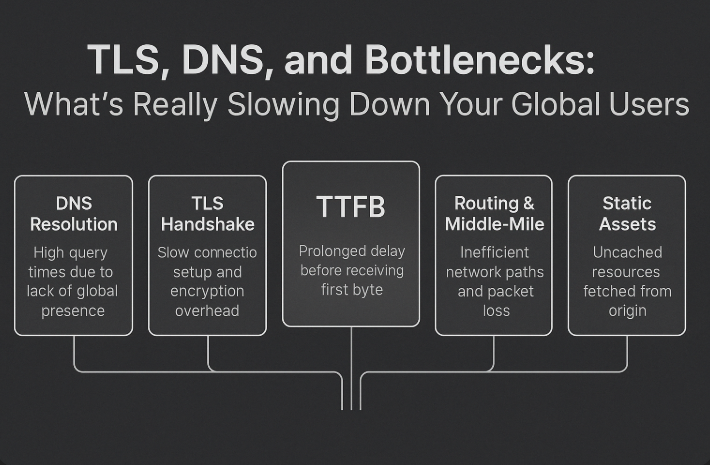
You're seeing complaints from users abroad. "Your site is so slow," they say. You check the server—it's healthy, well-provisioned, and located close to your expected audience. So what’s the real problem?
Let’s uncover the underlying layers that silently break your website's global speed. Spoiler: the server is rarely the villain.
1. DNS Resolution: The First Tripwire in the Journey
When a user visits your website, the first step is DNS resolution. If your DNS provider doesn't have global Anycast nodes, international users may experience query times exceeding 500–1000ms, even before your server gets touched.
Real Bottleneck:
Centralized or China-only DNS hosting
No Geo-based routing or EDNS client subnet support
Fix:
Use Anycast DNS with geo-optimized routing (e.g., Route 53, Cloudflare)
Deploy EDNS Client Subnet (ECS) for regional IP resolution accuracy
2. TLS Handshake: A Hidden Delay Multiplier
TLS (SSL) is essential for encryption, but the handshake process can be lengthy—especially with older protocols or multiple round trips.
Every new HTTPS connection includes:
TCP 3-way handshake
TLS handshake
Certificate validation (including OCSP or CRL checks)
For users in latency-prone areas, this adds 300ms–800ms before your server even starts processing.
Fix:
Upgrade to TLS 1.3 for 0-RTT resumptions
Terminate TLS at edge nodes/CDNs, not at the origin
Enable OCSP stapling and session resumption
3. TTFB: It’s Not Just the Backend
Time to First Byte (TTFB) is a commonly misunderstood metric. While it partly reflects server responsiveness, it also includes all pre-processing overhead:
DNS
TCP
TLS
Routing path delays
A backend response of 80ms can easily turn into a TTFB of 900ms with poor edge performance.
Fix:
Cache at edge whenever possible
Use edge computing or pre-rendered HTML for known routes
Enable dynamic route partitioning to reduce API congestion
4. Routing & Middle-Mile: When Distance Becomes Drag
It’s not about distance anymore—it's about network efficiency. Users in Brazil or Vietnam may hit entirely different network routes, each with its own bottlenecks:
Packet loss due to congested inter-ISP links
Long-haul TCP performance degradation
Firewalls & national network policies causing detours
Fix:
Use Global Accelerator services (like AWS GA, CloudFlew)
Deploy intelligent routing based on real-time health + latency
Layer in redundant regional PoPs for dynamic failover
5. Static Assets: Cached or Catastrophic?
If images, fonts, or JS files are not CDN-distributed, each request goes back to the origin, which might be halfway around the globe.
Large resources like web fonts or uncompressed media will disproportionately hurt users in low-bandwidth environments.
Fix:
Use immutable caching headers
Set appropriate max-age and cache control
Serve assets via HTTP/2 or HTTP/3 for multiplexed delivery
6. Your Users Aren’t You — Test Globally
Local testing (e.g., using Chrome DevTools in your city) tells you nothing about Jakarta, Paris, or Lagos. Latency, ISP quality, and packet loss vary wildly.
Fix:
Test globally using tools like Pingdom, Uptrends, or Catchpoint
Track metrics like DNS resolution time, TLS negotiation time, and TTFB per region
Final Insight: True Global Performance Comes from Architecture, Not Servers
It’s tempting to throw more CPUs at the problem, but cross-border speed is rarely fixed at the origin layer.
Global performance requires a strategy—one that spans:
nginx DNS → TLS → Routing → Caching → Edge Logic → Metrics
When optimized together, the result is a site that feels local anywhere in the world.

